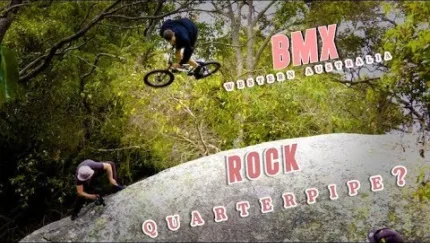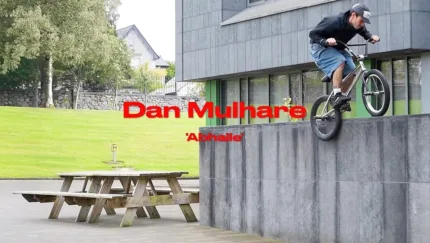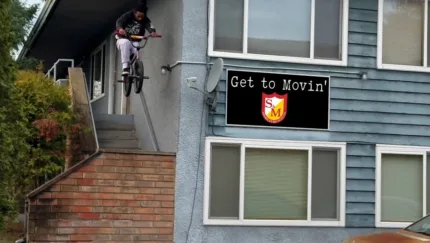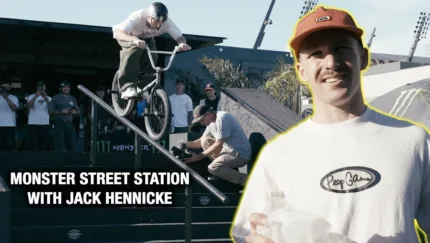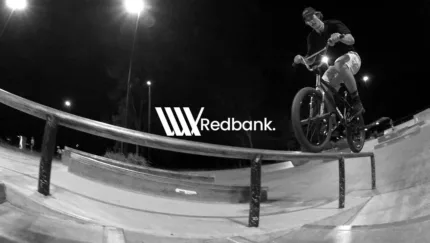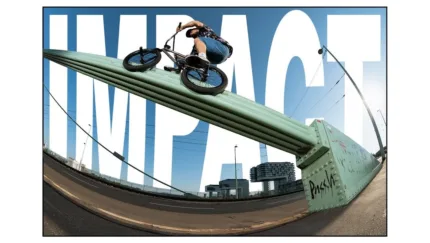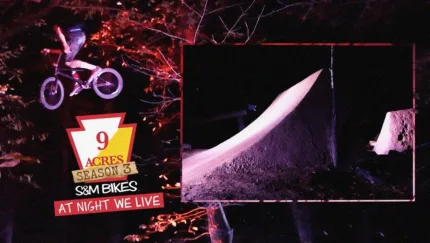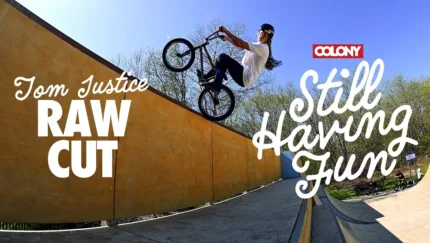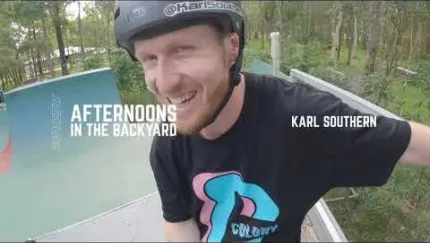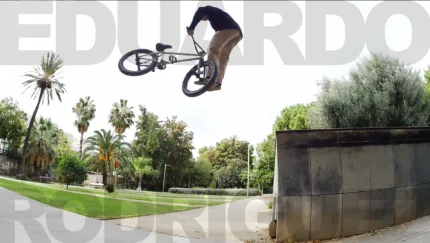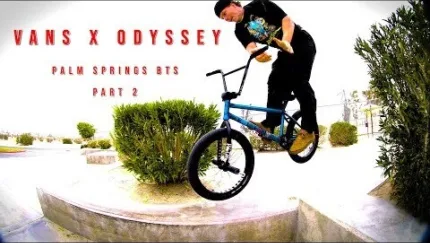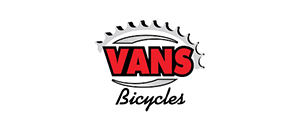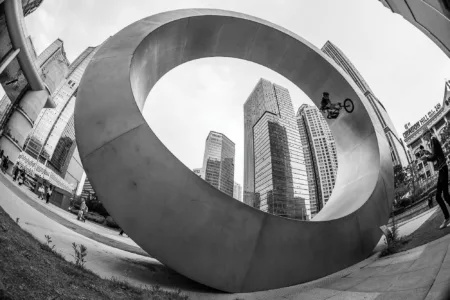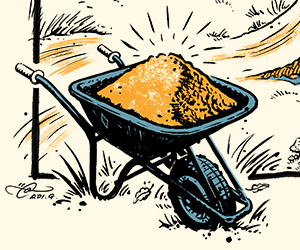
A Brave New World - The history of KHE Bikes, Part 2
Taiwan, a pornstar, and innovation in a can
Words by Thomas Fritscher | Images courtesy of KHE Bikes & Kay Clauberg
Previously on The History Of KHE Bikes: KHE owner Thomas Göring sent Albert off to Russia with love and a hand glued PVC prototype and he returned with a batch of a hundred Catweazle frames. What started as a means to ride some decent pegs was now officially a frame manufacturer.
Life seemed to continue rather normal in KHE land with the exception that some people were now on KHE frames, but all was about to change at Eurobike 1994 when Thomas stumbled upon the booth of a rather new Mountain Bike company called “Heavy Tools'' from Austria.

Heavy Tools was kind of a big deal back then. They were one of the first mountain bike companies and quite popular, especially in Germany. The booth showcased their mediocre interpretation of BMX bikes and Thomas’ took it on himself to let them know exactly what he thought of it. The result of this bluntness was a deal which not only gave Thomas a new job to design and spec Heavy Tools’ contribution to the BMX market but also left KHE as the main distributor for Heavy Tools Bikes in Germany. The biggest aspect however was that Thomas now had his foot in the door to Taiwan, where Heavy Tools was already working with a rather BMX-savvy agent.

Heavy Tools' contribution to the "Freestyle" market. It can't really be called successful, but sure opened some doors for KHE
After fiddling about with German and Russian companies for years, the means and possibilities in Taiwan blew his mind. This was the land of opportunities as far as he was concerned. So while container loads of Heavy Tools bikes landed in Karlsruhe and were shoved into Thomas and Wolfgang’s grandmother's cellar to ship them all over Germany (they didn’t have a proper warehouse yet), Thomas moved KHE’s production to Taiwan with the help of the new found connection. This is what Thomas describes as the point where KHE became a real company. For the first time he didn’t just sell stuff to make money for the next batch. The deal forced him to think big and he liked it.
He quit his job and Wolfgang soon followed, leaving behind his lifetime non-cancellable employment with an awesome pension at the state owned postal service.
"After fiddling about with German and Russian companies for years, the means and possibilities in Taiwan blew his mind. This was the land of opportunities as far as he was concerned."
At first though he didn’t want to be his own competitor and concentrated his efforts on the high end Catweazle complete. They specced the cheaper Heavy Tools bikes with KHE parts and expanded the team, making room for people like Christian Wendland and Alex Reinke on a blurry mixed HT/KHE team. After witnessing the success of the cheap Heavy Tools bikes however, he decided to enter the market with the first entry-level complete bike called “Cosmic”. Now this made things a whole lot easier on the international stage: Having a complete range of bikes available makes you interesting for big distributors he learned, so that’s where he went.

Cosmic was KHE's first step into the world of affordable completes
Times were changing though - BMX products were evolving fast again, this time in the right direction. Standard Bykes introduced what could be called the first frames of a new generation in 1992. The Standard Lengthy and Shorty redefined BMX "freestyle" frames and the Hoffman Bikes “Big Daddy” in 1993 continued that route, with proper dropouts, a no frills design and the promise to last a lifetime. So KHE was no longer up against flimsy Dyno’s and fragile Haro’s - the age of the overbuild behemoth had begun - best represented by S&M’s “Heavy As Fuck” from 94. A different approach was taken by Dyno’s founder Bob Morales. His new joint “Morales” entered the market with a super specific flatland frame in 1994, sporting an extremely short wheelbase and elevated chainstays for more clearance. That is what Jesse Puente was riding at the World’s in Cologne when Thomas approached him about a possible sponsorship. A deal was made about shin pads and parts but it didn’t take long before plans were made to create a signature frame.
"Jesse’s plans and ideas were specific and complicated - the drawings were received by fax (remember those?) and had to be transformed into something the engineers could use."

The construction plans for the KHE Premium Lagger frame were specific and on-point
This is when the Taiwan connection was put to a first proper test: Jesse’s plans and ideas were specific and complicated - the drawings were received by fax (remember those?) and had to be transformed into something the engineers could use. The design sported a huge front gusset and a triple bend in the seat tubes, and creating the tools to build this frame was expensive. But Jesse wouldn’t take no for an answer and the pressure was on to get this frame exactly the way he wanted it. Thomas vividly remembers how he, Christian and Harald Schmid (who was an intern at KHE at that time and went on to become co-owner and main product designer for wethepeople) pulled the first prototype out of the box: They created something special. The “Premium Lagger”, with a logo ripped off of a Heineken bottle, became an instant success in the flatland world. Sold over 3000 times til 2001 it reinforced KHE’s status as a premium flatland brand.
Phil Dolan
Effraim Catlow

The man himself, Jesse Puente, aboard his signature "Premium Lagger" frame
Nevertheless, KHE stayed committed to the whole of BMX and got Jason Davies on the team who designed the “Beater” for them. Up to the standard of those days, it sported the rather new “Aheadset'' system, heavy duty dropouts and an allround beefy build. The main purpose of getting Jason on the team however was to enter the british market and get to another english vert rider, Jamie Bestwick. Jamie has been so hot right now since the beginning of time basically and him signing with KHE brought another big player to the table who came with a bunch of money to start a new era for KHE and it’s team: The german sports shoe brand Puma, who wanted a piece of that extreme sports pie everyone was talking about. Puma sponsored the sizable team and paid its flagship riders a monthly salary. They took a fancy Puma / Virgin records nightliner to the Worlds in Holland and flew to Florida for commercial shootings. This enabled Thomas to spend more money on product development and the KHE brand grew massively in popularity all around the world. Big names joined the team, including Martti Kuoppa, Marton Szilagyi and Effraim Catlow. When Jamie won the worlds title in 1997 it didn’t take long for one Woody Itson to call Thomas though and lure Jamie away into the GT team. Thomas learned from several riders being pulled away from him by bigger companies and had a transfer fee included in Jamie's contract. Woody paid and the money went straight to a guy who would grow up to be Germany's biggest (quite literally) vert talent: Stefan Geisler.

Jason Davies also trusted the modern fax machine to realize his ideas for his signature frame.


Jason Davies RIDE BMX (US) cover April/May 1997
Around 1995 it was time to leave Wolfgang’s cubby and move into a proper office. KHE ended up sharing a warehouse with a local bicycle retailer for two years before the big move: the founding of a new company and the move to their own warehouse complex in 1997. In order to be more flexible, have more control and also save shipping costs and customs, KHE started to move the assembly of complete bikes to Germany. This enabled them to drop any minimal order lot sizes and fulfill even the smallest of orders coming from distributors from all over Europe.
The idea was later extended by a full wheel building setup of lacing-, truing and tyre mounting machines. This not only allowed a more efficient shipping from Taiwan, saving precious container space, but also made KHE eligible for customs exemption by Germany's anti dumping laws, which rewarded companies moving production back into the country.
In the heyday, KHE would assemble up to 150 bikes per day, mostly hi-end, with parts coming in from Taiwan, China, Finland and the USA.

Never afraid of weird publicity stunts, KHE announced a collaboration with the silicon heavy porno starlet Dolly Buster in 1999, who was making a name for herself with (dressed) appearances on German TV and movies at that time. Although it was said that she couldn’t even ride a bike, they went on a promotion tour to promote her “signature” bike, the “Dirty Buster”. This wasn’t the only time shady sex references made it into the KHE lineup but definitely the most prominent one. It wasn’t really one for the BMX audience but nevertheless gave KHE and BMX a lot of media presence in newspapers, yellow press and national TV.

The Puma / KHE Team from 1996. See if you can spot a Doctor of physics and Flatland World Champion 1993, the director of the German BMX video series “Beware” and legendary daredevil, a flatlander turned vert rider, a flatland pioneer and owner and founder of Moto pedals, the co-owner and main product designer of wethepeople/Eclat/Bombtrack, an esteemed hungarian flatland pro, video maker and producer of custom made handlebars, a British flatland legend and another British flatland legend and founder/operator of the largest flatland website today. And oh yeah, there is an X-Games guy up in the air as well. Standing, l to r: Christian Wendland, Albert Retey, Marcus "Kalle" Arnoldy, a Puma rep, Stefan Geisler, Geraldo Kittel, Ali Barjesteh, Harald Schmid Sitting, l to r: Marton Szilagyi, Phil Dolan, Meisler, Thomas Göring, Milton Apolonidis, Effraim Catlow. Up in the sky: Jamie Bestwick
In what seems to be a classic KHE timing faux-pas, Thomas started developing the idea of an internal Rotor system in the year 2000, right when the original T1 squad made the one-brake-long-cable setup popular and flatlanders started taking their brakes off. He pitched the idea to Diatech, for whom he already designed the Tech-99 levers. The result was the SD (“System Diatech”) Rotor, hidden away in a rather gigantic headtube and first presented to the public in KHE’s range of frames and completes, although the system was designed to be independently licensed by anyone willing to pay. The response in the “core” BMX community was mostly a mixture of ridicule and indifference but Thomas believed in the idea and the simplicity of the system helped to sell complete bikes. Almost instantly he started planning the refined and slimmed down version which eventually became F-Set in 2004 and now is Affix, which is almost indistinguishable from a regular headset but houses a complete rotor with easily exchangeable cables. The system is now a KHE exclusive.
The first generation "System Diatech" was rather voluminous and wasn't really embraced by the BMX community. It's simplicity helped sell completes though and the idea took up permanent residence in Thomas' head
Nowadays the internal rotor system “Affix” is virtually indistinguishable from a regular headtube
When the light bike craze was started by Ruben Alcantara in 2001, time came for engineering based companies like KHE to shine. Thomas was already running in that direction with the introduction of the “Easy Rider”, the first ever all aluminium flatland frame and fork in 2000. Butted tubing quickly became the rage and proclaimed resolution to the strength issues while keeping weight in check. Thomas teamed up with a Taiwanese producer to build the first multiple butted handlebars which he even managed to get patented for a year. It seems normal now but that was quite a big thing back then: KHE’s Sean Butler and Cory Walters Signature bars were significantly lighter than anything else available at that time. Thomas also experimented with conical tubing, aptly coined “Cone tube”, which started with a proper late 90s diameter by the steerer tube and slimmed down to the rear. The modern KHE frames of that era sported conical tubing everywhere down to the seat- and chainstays. New products which focused on lightweight engineering included an aluminium stem/handlebar combo for flatland and the resurrection of the Uni Seat, which is combined seat with seatpost originally made in the late 70s / early 80s by a company that was oddly enough already mentioned in the first part of this story. KHE brought back that one, relieving all the kids from zip tying their seats to the frame. KHE’s new hi-end street complete “Mad Max'' replaced the ageing “Dirty Harry” and Beater bikes featuring all the latest tech KHE had to offer. They also retired the “Cosmic” and replaced it with a bike named after the main character in a TV show that was Germany's most successful TV export ever: Derrick. Now that is some foundation for success.
"Thomas also experimented with conical tubing, aptly coined “Cone tube”, which started with a proper late 90s diameter by the steerer tube and slimmed down to the rear."
of 3
So once again, things were looking up for KHE. The in-house assembly much closer resembled Thomas’ idea of a bike company, giving him the opportunity to offer jobs in his warehouse and keeping a close check on product quality. He lost some of his credibility in the BMX scene but gained mass market share and the means to maintain a large team of riders that was constantly crowing. They began working on a successor for the Premium Lagger and the next rendition of the Freecoaster hub, which helped make them big in the first place.
The first advert for the new foldable “Premium”-tyres. The tyres were later relabelled to “MAC”
MAC tyres nowadays are available in all sizes and colours (as long as it's a shade of black)
The big one however turned out to be the product of a sweet deal with a manufacturer which helped KHE design the first foldable kevlar freestyle tires back in 2006. The idea wasn’t new, in fact Tioga offered the "Comp 4" in 1984, a pretty unsuccessful successor to the all time classic Comp 3, sporting a kevlar bead and shipped in a fancy box to showcase its folding qualities, but in what we call freestyle, it was. The casing of a tyre is traditionally made out of cotton and while this ensures a rather comfortable ride it also makes the tyres heavy and size specifications pretty vague. The KHE foldable “Premium” tyre used kevlar in the casing and the bead, cutting the weight dramatically and making it true to size, which was of course given in millimetres to confuse the hell out of Americans. The “Premium” was so successful that KHE quickly upped themselves, introducing the tyres in three different sizes and a park, street and dirt model. The “MAC” series tyres remains one of the best selling products in KHE’s range, and the one product that riders of those other brands turn to when looking for lightweight and durable tyres.

KHE Freecoaster advert with Bruce Crisman from 2007. The “Reverse” coasters were the successors to KHE's first 14mm freecoasters ever
So by now KHE found their niche in the BMX world. They weren’t “core” anymore, by any means, but kept pushing the envelope and advancing BMX technology. The company came a long way from machining pegs out of scrap aluminium in a basement apartment. New talent was added to the team, Thomas kept experimenting with new materials and production methods and with the help of Bruce Crisman once again delivered the blueprint for freecoaster hubs, the one thing that helped build KHE’s reputation in the first place. But BMX remained an unstable market, subject to ups and downs and big turnover seldom comes without big risk – a fact the Göring brothers were about to learn the hard way. But more of that later. - TF
For more info visit our Official DIG Partners: KHEBIKES.com
Previous
PROJECT X
This is Project X - This is BMX
Next
KEEPING IT LOCAL - 20 YEARS OF KELVINGROVE SKATEPARK
Happy Birthday to our local Glasgow park.
Related Content












